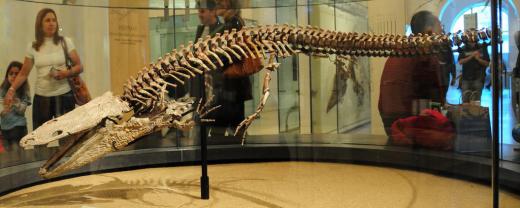What are Temnospondyls?
 Michael Anissimov
Michael Anissimov
Temnospondyls are an odd and diverse group of very early amphibians which lived in a variety of habitats, as long as they were in or near water. Temnospondyls were common during Carboniferous, Permian, and Triassic times, and a few species even survived in geographically isolated zones through the Cretaceous. Temnospondyl fossils range in age from 310 to about 112 million years ago, for a total duration of almost 200 million years, 40 million years longer than the dinosaurs. There is disagreement among paleontologists as to whether temnospondyls left no ancestors or evolved into some modern amphibians. Formerly it was thought that they were the ancestors of frogs, but this view has since fallen into disfavor.
The typical temnopsondyl had a wide, crocodile-like head and a smaller reptilian body, although there were variants with barrel-shaped bodies, salamander bodies, and alligator-like heads. The temnospondyls were among the first tetrapods, and the earliest, like Dendrerpeton, resembled small lizards. Temnospondyls are part of a now-obsolete group called labyrinthodonts, which includes the non-amphibian basal tetrapods, the ichthyostegids. Temnospondyls were the most numerous land animals during the Carboniferous and Permian, i.e., throughout the late Paleozoic era. At the time, tetrapod diversity was low in comparison to recent times. One of the only other land groups were lepospondyls, which included lizard-like, newt-like, eel- or snake-like forms that took specialized niches not occupied by temnospondyls. Some lepospondyls are famous for their U- or V-shaped heads.

The late Paleozoic has been called the "Age of Amphibians" because amphibians had emerged and began to occupy numerous available terrestrial niches, including predators and herbivores ranging from a few inches in diameter to prehistoric giants like the 9 m (30 ft) Prionosuchus, a crocodile-like temnospondyl that lived during the late Permian, known as the largest amphibian fossil ever found. Temnospondyls ate practically anything edible at the time, including fish, insects, mollusks, and each other. They colonized the world's first forests.
AS FEATURED ON:
AS FEATURED ON:











Discussion Comments
I think it is fascinating that fossil remains of the Temnospondyl have been found on every single continent. They were different sizes and included the basal medium-sized Dendrerpeton and even the large Cochleosaurus.
These great creatures flourished in the lakes and rivers and many became more dependent on water life. This led to their vertebrae becoming weak and the limbs becoming smaller. These were the classis Stereospondyli. They dominated the ecosystem of the fresh water.
There was one group of very successful long snouted fish eaters known as the trematosaurs which adapted to life at sea.
@snowywinter: The name Temnospondyl comes from the Greek word “temnein” which means “to cut”. Spondulus, means “vertebra”.
This incredible creature flourished during the Permian, Triassic, and Caboniferous periods. There were still a few stragglers in the Cretaceous period, as well. They adapted well and could live in a wide range of habitats including semi-aquatic, amphibious, fresh-water aquatic, terrestrial, and even near-shore marine.
How did they come up with the name Temnospondyl? Sounds kind of weird to me.
Post your comments